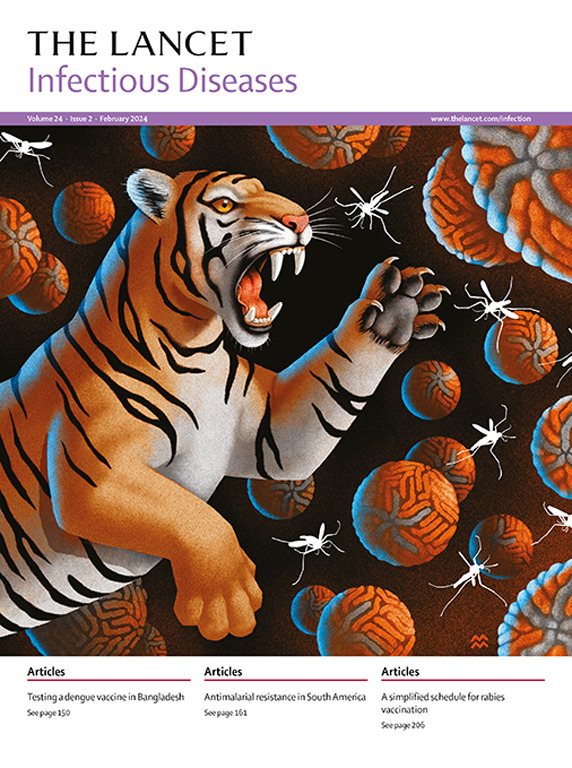Effects of conditional cash transfers and pre-test and post-test tuberculosis counselling on patient outcomes and loss to follow-up across the continuum of care in South Africa: a randomised controlled trial
IF 36.4
1区 医学
Q1 INFECTIOUS DISEASES
引用次数: 0
Abstract
Background
Economic and behavioural factors lead to poor outcomes in patients with tuberculosis. We investigated the effects of a package of interventions consisting of pre-test and post-test tuberculosis counselling with conditional cash transfers on patient outcomes in adults undergoing investigation for pulmonary tuberculosis.Methods
This pragmatic, open-label, individual randomised controlled trial was done in nine clinics in Johannesburg, South Africa. Participants (aged ≥18 years) undergoing investigation for tuberculosis were randomly assigned (1:1) to the intervention group or control group (standard of care) via permuted block randomisation, stratified by clinic; group assignment was concealed using opaque envelopes. The intervention group received pre-test and post-test tuberculosis counselling, and for participants diagnosed with rifampicin-susceptible tuberculosis, a digital payment (R150; approximately US$10) at treatment initiation and each monthly treatment visit. Payments were contingent on timely attendance: 14 days from initial sputum sample collection and within 7 days on either side of their scheduled monthly appointment. The primary endpoint was successful patient outcome (patients who were cured or completed treatment) or unsuccessful patient outcome (pretreatment loss-to-follow-up, on-treatment loss-to-follow-up, development of rifampicin-resistant tuberculosis while on treatment, treatment failure [ie, smear or culture positive at 5 months or later after commencing treatment], or death). The primary outcome was analysed in the modified intention-to-treat population, defined as all randomly assigned participants with rifampicin-susceptible tuberculosis confirmed before the commencement of tuberculosis treatment. Weighted outcome prevalence, relative risks (RRs), and risk differences were calculated using a multivariable Poisson model with robust standard errors. This trial is registered with the Pan African Clinical Trials Registry (PACTR202410708311054) and is completed.Findings
Between Oct 25, 2018, and Dec 9, 2019, 4110 participants were enrolled and randomly assigned, 2059 to the intervention group and 2051 to the control group. 381 (9·3%) participants had microbiologically confirmed rifampicin-susceptible pulmonary tuberculosis (195 [9·5%] of 2059 in the intervention group vs 186 [9·1%] of 2051 in the control group; median age 37 years [IQR 30 to 45], 257 [67·5%] male, 124 [32·5%] female). At study closure, primary outcome data were available for 128 (65·6%) of 195 participants in the intervention group and 139 (74·7%) of 186 participants in the control group. 105 (82·0%) of 128 participants in the intervention group and 93 (66·9%) of 139 participants in the control group had a successful patient outcome; 23 (18·0%) of 128 participants in the intervention group and 46 (33·1%) of 139 participants in the control group had an unsuccessful patient outcome. The weighted regression analysis showed a substantial reduction in the risk of unsuccessful patient outcomes in the intervention group compared with the control group (weighted prevalence 15·9% vs 28·6%; RR in weighted population 0·52, 95% CI 0·33 to 0·82; risk difference in weighted population –14·1 percentage points, 95% CI –23·3 to –4·8). Pretreatment loss to follow-up was lower in the intervention group than in the control group (unweighted population: five [3·9%] of 128 participants vs 22 [15·8%] of 139 participants; risk difference in weighted population –9·6 percentage points, 95% CI –14·9 to –4·2).Interpretation
The package of interventions consisting of pre-test and post-test tuberculosis counselling with conditional cash transfers significantly reduced the risk of unsuccessful tuberculosis patient outcomes, bringing one of the 90–90–90 targets within reach (ie, achieving 90% tuberculosis treatment success). Furthermore, reduction in pretreatment loss to follow-up is expected to reduce transmission and lower incidence of the disease over time.Funding
South African Medical Research Council, UK Medical Research Council, and Newton Fund.求助全文
约1分钟内获得全文
求助全文
来源期刊

Lancet Infectious Diseases
医学-传染病学
CiteScore
60.90
自引率
0.70%
发文量
1064
审稿时长
6-12 weeks
期刊介绍:
The Lancet Infectious Diseases was launched in August, 2001, and is a lively monthly journal of original research, review, opinion, and news covering international issues relevant to clinical infectious diseases specialists worldwide.The infectious diseases journal aims to be a world-leading publication, featuring original research that advocates change or sheds light on clinical practices related to infectious diseases. The journal prioritizes articles with the potential to impact clinical practice or influence perspectives. Content covers a wide range of topics, including anti-infective therapy and immunization, bacterial, viral, fungal, and parasitic infections, emerging infectious diseases, HIV/AIDS, malaria, tuberculosis, mycobacterial infections, infection control, infectious diseases epidemiology, neglected tropical diseases, and travel medicine. Informative reviews on any subject linked to infectious diseases and human health are also welcomed.
 求助内容:
求助内容: 应助结果提醒方式:
应助结果提醒方式:


